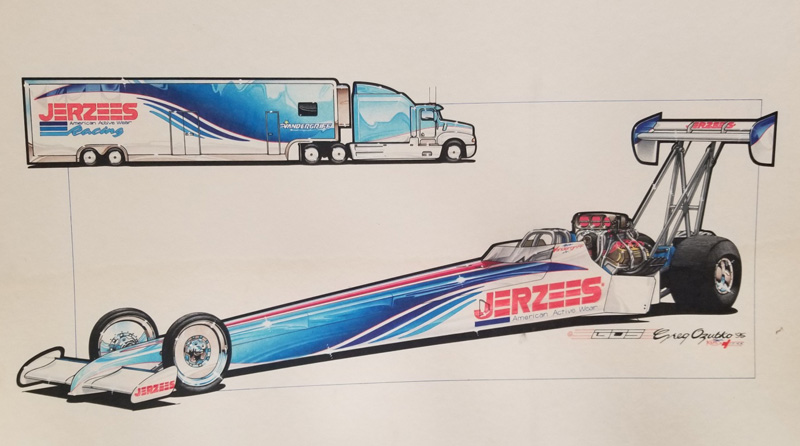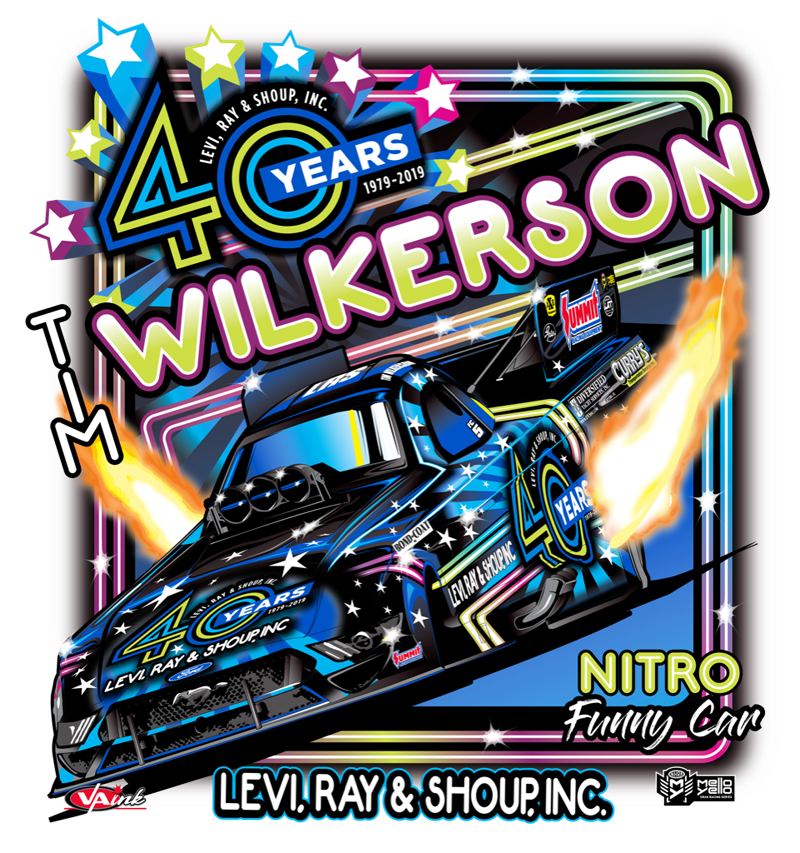THROUGHOUT THE YEARS, OZUBKO HAS ADJUSTED TO SERVE THE INDUSTRY

 Greg Ozubko has always had the soul of an entrepreneur.
Greg Ozubko has always had the soul of an entrepreneur.
From a simple start drawing cars as a kid of “five or six,” Ozubko turned his passion for art, business and drag racing into a career. As a teen, he sold the pieces he produced at home -- and school, as it would turn out -- to the competitors at his home track in Edmonton, Alberta, Canada.
That led him into the field of racecar design, then apparel, and today, in Alpharetta, Georgia, the 55-year-old Ozubko is among the leaders in his field. GOS Motorsports Graphics employs a half-dozen employees -- seven when the workload is heavy -- to keep pace with the demand.
“When the late 80s came and I was probably 25, I was probably doing 200 cars a year,” he said of his design schemes. “But I ran it like a business. Some of the great artists, like (Kenny) Youngblood, are artists at heart, but if I wasn’t getting paid to draw, I wasn’t drawing anything.
“God blessed me with this talent to do it, but it’s the business side of it that I enjoy. ... I always liked cashing the check more than anything else.”
He got an early start on that as a child, using felt pens to transfer what he envisioned into something tangible. At about age 10, local dragstrip promoter Ron Hodgson “took me under his wing,” and that gave Ozubko an avenue to become a constant presence at the facility.
“What I originally did was acrylic paintings, and I sold them to guys when they came into town. They weren’t very good, but they weren’t horrible, either” Ozubko said. “It grew from there with these paintings. Eventually I got to where I was pretty good at those.
“I kind of developed over time. My middle teens to high school, I was taking orders at the track for paintings. I scammed my teacher at the time into letting me to do that instead of drawing bowls of fruit, which had no interest to me at all and was going to have an issue with. She saw that I had this other ability, so I’d take in my paintings from the track, get a grade on them, then them around and turn them over to the customer for $250 to $500, something like that.”
Each of those paintings required several weeks to complete and produced one payment. He quickly deduced that he could increase his income with something that required a smaller investment of his time. That’s when he began creating his own racecar designs, using a template of a generic car and an art pencil to churn out one a day.
He had the business sense, even as a teen, to insist on payment in American dollars, running his revenue for each piece to about $350.
“That,” he said of design schemes for racecars, “is the part that really grew.”
Ozbuko attended the University of Alberta and shuffled through a series of majors like a deck of cards: computer science, accounting, pre-law. He eventually decided to pursue his passion for racing art as a career and left school with a Bachelor of Science degree.
Much of his business came via word of mouth and an ad each autumn in National Dragster, NHRA’s official publication.
 “Right at the World Finals results issue, I’d have a third or half-page ad in there, and that would keep me busy through the next year until I did it again,” he said. “That only took so long before the reputation really grew.
“Right at the World Finals results issue, I’d have a third or half-page ad in there, and that would keep me busy through the next year until I did it again,” he said. “That only took so long before the reputation really grew.
“I had deals with a lot of the chassis builders. Jerry Bickel was the first one, in 1988, to do a paint scheme for a car he was building. My recollection is along the lines of ‘if you make it look better, that’s an advantage to me because most people can’t see the neat stuff I did under the hood, but we can at least make it look good.’ It also helped in the ease of the process of selling that to the customer, making his car look better, and I can do the paint scheme handled from one end to the other. From that, it grew to all the other chassis builders: Haas, McAmis, Mauney, Ness, Rick Jones, Larry Jeffers -- they’ve all sent customers my way.”
After becoming good friends with Georgia Top Fuel racer Bob Vandergriff Jr., Ozubko, then 34, moved to the United States in 1997 to get more heavily involved in the sport. He would prepare the artwork for each project, and Vandergriff’s company churned out the shirts.
Eventually, the need for handpainted and drawn designs was replaced by computer renderings. When Vandergriff decided to devote more time to his racing program, Ozubko took over the other half of the business. Both men and Vandergriff’s father operate out of the same facility in Alpharetta, Georgia.
Computers “killed the graphics side of the business in the sense that what used to take a long time didn’t take that anymore. The software did that for you,” Ozubko said. “As a result, I focused a lot more on the apparel side of things.
“The vast amount of my day is running the T-shirt business than doing the artwork. I’m still doing paint scheme stuff and T-shirt designs, and now I have people that -- when I get a design approved -- they execute the process from there, and I can focus on the next, more important thing.”

It’s a business whose products have become more upscale from year to year.
“Back then, T-shirt designs looked like a 5-year-old did them; very basic. Now, we have a 12-color press and a 16-color press, so we have elaborate stuff.
“Guys will build cars and get a new paint scheme,” he continued. “Well, then they need a T-shirt. It occurred to me that everybody else is making money off of my piece of artwork. Like every other naive idiot, you think there’s a lot of money in these things, and there’s not. That whole process, it’s not as lucrative at what everybody thinks it is. It’s not NASCAR; it’s not a retail basis, it’s guys ordering 288 shirts, 500 shirts, that type of thing, a few times a year. You scratch out a pretty good living, but it’s not as lucrative as you think.”
Eventually, he branched off into doing renderings of cars and team transporters for clients who wanted something visual to present to potential sponsors.
“It’s no different than doing a paint scheme,” he said, “but instead of doing a bunch of different designs, we’re doing a really nice, professional rendering for the XYZ Company, and the racer would take that in and pitch it. … Sometimes it worked and most times it didn’t. But it was a professional approach that helped sell a program.
“Anytime a guy walks into a sponsorship scenario, before it had evolved into a lot of the more technical marketing partners, business-to-business relationships that it is now, back then you were really just trying to ‘I’ll put your name on the car this big’ as he was sitting there trying to tell them how great drag racing is. It was a lot of food for Joe Sponsor’s head. But when they’d take out the rendering, that was something that was emotional, that’s where the guy could get excited about it. Now they’re looking at their name and logo on this cool-looking racecar.”

The apparel line doesn’t end at T-shirts. It also includes a full array of products, from hoodies to long-sleeved gear, tank tops, hats … “whatever you can imagine.”
So what’s a successful businessman like Ozubko do for kicks?
He harkens back to the athletic pursuits of his youth and being Canadian, it’s no surprise that that means ice hockey, a sport he played competitively until he was about 20.
A goalie, Ozubko happened to be in the right place at the right time at an Atlanta-area ice rink and was invited to practice with some NHL Atlanta Thrashers players. Their allegiance and hometown was about to shift north to Winnipeg, Manitoba, after the Thrashers were sold.
One day, when the Atlanta Gladiators of the Double-A ECHL were shorthanded for goalies, Ozubko was invited to fill the void for the team’s intrasquad game. “Mark Cheverie, who was a draft pick of Phoenix, was the other goalie. I won it, and how I did it, I have no clue,” he said.
Eight years ago, at age 47, Ozubko was first on the Gladiators’ active roster as what’s known as an EBUG, or Emergency Back-Up Goaltender.
“My kids are 29 and 28 now,” he said. “I have kids that are older than a lot of the guys in the dressing room. I’ve probably dressed for about a dozen games. I absolutely love it. That’s my first love, my true passion.”
Perhaps there’s a market out there in the hockey apparel design and production business, too. Ozubko already has the skills and equipment in place to make it work.
Ozubko can be reached via email at gosmsg@bellsouth.net
And not a scratch on the car in the aftermath. Quite the save. - https://t.co/MgFfAjWfI2 pic.twitter.com/4Kqeic6VaL
— Competition Plus (@competitionplus) October 9, 2019







































